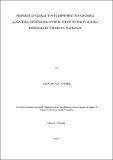| dc.contributor.author | Jondiko, Eric Omolo | |
| dc.date.accessioned | 2018-05-02T08:14:42Z | |
| dc.date.available | 2018-05-02T08:14:42Z | |
| dc.date.issued | 2010 | |
| dc.identifier.citation | Jondiko, E.O. (2010). Response of Clonal Tea to Different Tea Growing Locations, Nitrogenous Fertiliser Rates and Plucking Intervals in the Kenya Highlands, MSc Thesis (Chemistry), Maseno University, Kenya | en_US |
| dc.identifier.uri | https://repository.maseno.ac.ke/handle/123456789/490 | |
| dc.description | Master of Science in Chemistry Thesis | en_US |
| dc.description.abstract | Tea Camellia sinensis, is widely grown in the highlands of Kenya for manufacture of mainly black tea. The most costly inputs in tea cultivation are nitrogenous fertiliser and plucking which are key determinants of yield and quality. Previous studies evaluated yield and quality responses in single locations and results used to draw general agronomic recommendations. Consequently, recommendations are uniform in different locations despite variations in conditions responsible for growth. Blanket input use, may be subjecting some locations to lower yield and quality. Trials were conducted in five different tea growing locations in Kenya to assess yields and quality response of clone BBK 35 cultivar to location of production, nitrogenous fertiliser rates (0, 75, 150, 225, 300 Kg N/ha/year) and plucking rounds (7, 14, 21 days). From each location the green leaves were plucked and yield recorded. On three occasions when plucking intervals coincided, leaf was CTC manufactured and quality determined. There were significant (P ≤ 0.05) yield increase and quality decline with increasing nitrogenous fertiliser rates at all locations, with significant (P ≤ 0.05) interaction between geographical area of production and nitrogenous fertiliser rates in yields, demonstrating that the pattern of yield response of clone BBK 35 to nitrogen varies with locality. All the plain black tea quality potentials except thearubigins varied significantly (P ≤ 0.05) with location of production. It is therefore impossible to make black tea with similar black tea quality parameters in all the locations. There were significant (P ≤ 0.05) yield responses in various locations with three locations indicating yield increase with plucking intervals and two indicating decline with increase in plucking rounds with significant (P ≤ 0.05) interaction between location and plucking intervals in yields, demonstrating that the pattern of yield response of clone BBK 35 to plucking intervals did not occur uniformly. Theaflavins, thearubigins, total colour, brightness and taster A and B scores varied significantly (P ≤ 0.05) with plucking intervals while theaflavins, brightness and taster B declined while thearubigins and total colour increased at all locations. Quality of black tea declined with long plucking intervals at all locations. To increase yield in tea production, it is necessary to optimise nitrogen fertiliser application rates and plucking intervals for different locations. Shortening plucking intervals also leads to maximisation of quality. The various tea growing locations in Kenya therefore require different agronomic inputs to maximise on yield and quality | en_US |
| dc.language.iso | en | en_US |
| dc.publisher | Maseno University | en_US |
| dc.subject | Black tea, quality, area of production, nitrogen, plucking intervals | en_US |
| dc.title | Response of Clonal Tea to Different Tea Growing Locations, Nitrogenous Fertiliser Rates and Plucking Intervals in the Kenya Highlands | en_US |
| dc.type | Thesis | en_US |

